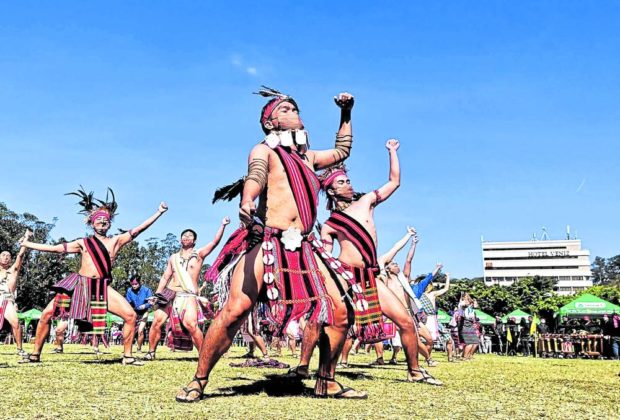
GETTING ITS RHYTHM BACK | The rhythmic beat of gongs rings out again at the Panagbenga Park at the fork of Session Road’s extension and Burnham Park in Baguio City, signaling the opening of this year’s subdued flower festival, after a two-year hiatus caused by the pandemic. (EV ESPIRITU / INQUIRER NORTHERN LUZON)
BAGUIO CITY, Benguet, Philippines — The familiar rhythm was played on highland gongs once again for Sunday’s opening ceremonies of the Baguio Flower Festival, more popularly known as the Panagbenga, as dancers in colorful Cordillera garments performed at Burnham Park for the first time in two years since the onset of the coronavirus pandemic.
“It never dawned on me — and it may have never occurred in your minds—that our yearly festivities would be interrupted for two years by a devastating … pandemic with which we are grappling until now,” former Mayor Mauricio Domogan, chair of Baguio Flower Festival Foundation Inc. (BFFFI), said at the kickoff ceremony for the event which had previously drawn thousands of tourists to the city each February.
This year’s Panagbenga (Kankana-ey for “the season for blossoming”) Festival, which was moved to March as the mountain city dealt with a surge of coronavirus cases last month, still cannot allow the flower-decked float parade because of COVID-19 regulations.
‘Session Road in Bloom’
Instead, Panagbenga 2022 will highlight its landscape exhibition at Burnham Park’s Football Field, which began on Sunday and runs until March 27, and the weeklong street bazaar “Session Road in Bloom” beginning March 21—with participating vendors reduced by about 100 from the original 500.
“Let a Thousand Flowers Bloom,” an annual family poster and banner painting event, will be held on March 13, while the Montañosa Film Festival will be held at Burnham Park Athletic Bowl from March 19 to March 27.
Opening the festival, Mayor Benjamin Magalong said the return of Panagbenga sends the message that Baguio will achieve a “new normal earlier than expected.”
He said the festival will be the “jumpoff point to revitalized tourism.”
The city, now under the most relaxed quarantine status alert level 1, had seen a huge drop in active COVID-19 cases of late, with just one new infection recorded on Saturday.
There are currently 82 active cases, compared with the start of the year when the city had over a thousand infections.
Impact of pandemic
The festival was conceived and launched in 1996 by lawyer Damaso Bangaoet and other civic leaders to draw back tourists to Baguio after its devastation in the 1990 Luzon earthquake.
It began with the help of employees of the now-defunct John Hay Poro Point Development Corp. In recent years, volunteers of the Baguio Country Club and of the Hotel and Restaurant Association in the city led the preparation of the festival activities.
In 2020, the BFFFI spent P5 million in organizing the festival, but this was suspended as the pandemic began to spread in the country.
Baguio lost an estimated P1.6 billion from tourism during that period. The Cordillera region as a whole needed up to P33.4 billion to recover after its gross domestic product contracted by 9.9 percent that year.
The pandemic had been hard for the city’s 5,000 tourism workers, artisans and performers who “depended only on tourism receipts,” Magalong said.
‘Remarkable improvements’
Domogan said the essence of reviving the city’s most popular tourism was to show people that “if we continue to dream together, to hope together in the spirit of unity, no calamity, no disaster, no catastrophe would be so gargantuan that we cannot fight, subdue and overcome it.”
“Panagbenga lives anew,” Magalong said, adding that Baguio’s COVID-19 response led to “remarkable improvements.”
As of Saturday, the city has fully vaccinated 278,490 out of a target adult population of 280,000 and 33,490 minors between 12 and 17 years old out of an estimated pediatric population of 40,238.
The mayor surprised the audience at Burnham Park when he asked them to briefly remove their masks so they could “Breathe Baguio,” the summer capital’s new marketing slogan.
He then quickly told them to put their masks back on.
“We need to learn how to live with the virus,” Magalong said, so Panagbenga could be staged with its “full splendor and magnificence next year.”
RELATED STORY
25 years of Panagbenga help Baguio retain its summer capital fame

